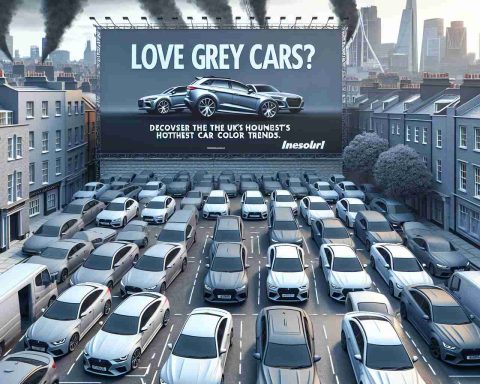Trending Colors in the UK Car Market
Car color preferences in the UK have remained remarkably consistent. Last year, nearly half of all newly registered vehicles were either grey or black. According to the Society of Motor Manufacturers and Traders (SMMT), grey continued its reign as the top choice, making up a significant 27.8% of new car registrations—marking its seventh consecutive year in the spotlight.
Black followed closely behind, capturing 21.7% of the market. This year also saw a surprising shift as blue took over the third spot with 14.9%, while white barely missed the mark at fourth place, showcasing a close competition. Red cars occupy fifth place, struggling with their lowest share since 2003.
While traditional colors dominate, there’s a growing interest in green vehicles, with 3.5% of all cars registered being this color—its highest percentage in nearly two decades. Interestingly, grey remains the favored choice even among electric vehicle buyers.
Despite the diverse palette of 93 colors available, pink emerged as the least popular, registering a mere 145 vehicles. The continuing trend indicates that British car buyers remain hooked on classic, muted shades, favoring resale potential over bold choices.
As you plan your next car purchase, consider these trends. Opting for a popular color could make selling your vehicle a breeze years down the line. Ready to upgrade? Carwow connects you with trusted dealers for unbeatable offers from home.
Color Trends and Their Broader Implications in the UK Car Market
The enduring dominance of muted colors in the UK car market, particularly grey and black, resonates beyond mere aesthetic preference, reflecting significant cultural and economic trends. The preference for these shades suggests a societal inclination towards functionality and resale value, where practicality trumps individuality. As consumers lean towards colors that maintain market demand, the implications can be observed in the broader contours of consumer behavior and marketing strategies across industries.
Moreover, the rising interest in green vehicles signifies a shift towards environmental consciousness among consumers. As 3.5% of cars registered are green, this marks a pivotal moment in the automotive sector, indicating an emerging demographic of eco-conscious buyers. Such trends are likely to propel manufacturers towards more sustainable practices and innovations, embedding environmental considerations within future design and production cycles.
Looking forward, we can anticipate a potential resurgence of bolder colors as sustainability becomes a core marketing narrative. Manufacturers may innovate with new eco-friendly paints or finishes that not only appeal aesthetically but also communicate an alignment with environmental values. As the industry evolves, these color trends will serve as barometers of changing consumer sentiment, highlighting the intricate interplay between society, culture, and the global economy.
Discover the UK Car Color Evolution: What’s Hot and What’s Not
Car Color Trends in the UK: An Overview
The UK car market has shown remarkable consistency in color preferences, with grey continuing to dominate in the latest figures. According to the Society of Motor Manufacturers and Traders (SMMT), grey accounted for 27.8% of new car registrations last year, marking its seventh consecutive year at the top of the list.
Top Color Choices: A Closer Look
Following grey, black secured its place as the second most popular color with 21.7% of registrations. Blue made an impressive leap to the third spot, claiming 14.9%, while white lingered closely behind. Red, perfectly embodying the “classic” car color, edged its way to fifth but experienced its lowest share since 2003, highlighting a trend toward more understated shades.
# Key Statistics:
– Grey: 27.8%
– Black: 21.7%
– Blue: 14.9%
– White: Nearly equal to blue
– Red: Lowest share since 2003 (exact percentage not specified)
The Rise of Green: A Sign of Changing Tides
A notable trend is the increasing interest in green vehicles, with 3.5% of new registrations representing this color. This marks the highest percentage in nearly two decades, suggesting that eco-conscious buyers are starting to influence market preferences.
Least Popular Colors: The Exceptions
While the spectrum of color choices includes a staggering 93 options, pink emerged as the least favored with only 145 registrations. This stark comparison further reinforces the preference for more traditional, muted tones among British car consumers.
Market Insights and Strategic Considerations
For potential car buyers, understanding these trends is crucial. Choosing a popular color can significantly enhance resale value and make selling easier in the future. As you navigate your car purchase, consider connecting with trusted auto dealers for competitive offers. Platforms like Carwow can assist in finding the best deals available from the comfort of home.
Pros and Cons of Choosing Popular Car Colors
Pros:
– Higher resale value
– Easier to sell in the future
– Better availability for common maintenance and repairs
Cons:
– Less individuality
– Potential for reduced visibility in a sea of similar cars
– Possible challenges with distinguishing your vehicle in crowded parking lots
Predictions for Future Trends
Experts suggest that as electric and hybrid vehicle adoption rates rise, we might see a gradual diversification in color choices as buyers seek to express their personal style and eco-consciousness.
Conclusion: The Future of UK Car Colors
The British car market’s love for grey and other muted tones shows no signs of waning, but increasing interest in green options suggests an evolving landscape. For more insights into automotive trends, visit CarsGuide.
Understanding these dynamics is essential for anyone looking to make informed decisions in the car market. Stay tuned to the trends for the best choices!









